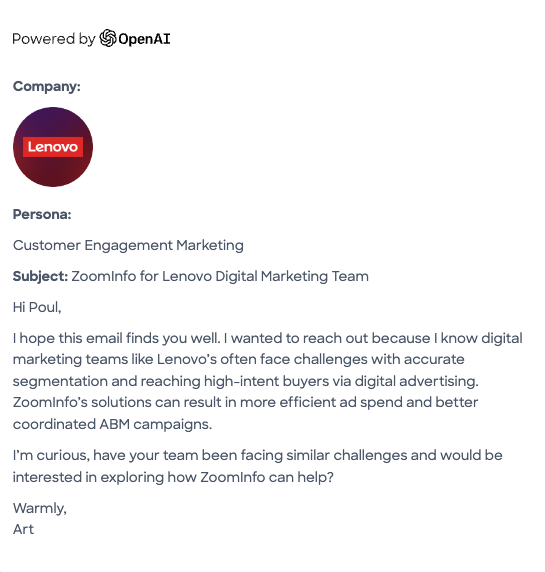Depending on who you ask, generative AI will either enhance every aspect of life, or usher in the kind of techno-dystopian nightmare that was once the sole province of science fiction movies. But what will generative AI really do? Some believe that generative AI technologies will save the tech industry, insisting that AI can help regain the trust of both the public and investors and solve the sector’s most urgent problems. Others, including thousands of notable founders and technologists, believe that the risks have been underexplored, and that placing vital systems under AI control prematurely might have disastrous consequences.
Divisive as they may be, these systems are already changing how sales professionals prospect for new leads, automate common tasks, and engage with customers. And the pace of technological advancement in generative AI is likely to accelerate for the foreseeable future.
Ben Salzman, SVP of ZI Labs and GTM Strategy at ZoomInfo, thinks that generative AI is already having a positive effect on go-to-market motions by encouraging sales and marketing leaders to experiment and question conventional wisdom.
“Generative AI is going to allow companies to run so much faster,” Salzman says. “Producing good content will be faster, designing strategic workflows will be faster, identifying audiences and executing data queries will be faster – it’s accelerating the pace of innovation.”
However, before we examine how these technologies will continue to reshape the landscape of modern sales, it’s important that we take a look at what generative AI is – and isn’t.
What is Generative AI?
As its name implies, generative AI is a technology that can produce various outputs, such as strings of text, images, or animations, based on a prompt entered by a user.
This means that, while futuristic visions of nefarious machines bent on our destruction might make for more compelling copy, these systems cannot produce outputs by themselves; they can only produce outputs based on user inputs.
Generative AI technologies are typically trained on large volumes of data, known as datasets. Given that the Internet is the single largest repository of human knowledge ever conceived, it’s hardly surprising that the Internet is a crucial tool for computer scientists developing generative AI systems, or that many generative AI tools have been developed using online datasets. (It’s also why several high-profile, yet ultimately failed endeavors were taken offline shortly after going live in recent years.)
What about ChatGPT?
ChatGPT, which stands for Chat Generative Pre-trained Transformer, is an AI chatbot(which are sometimes referred to as “conversational agents”)developed by OpenAI, first released in 2022. Based on OpenAI’s large language models, ChatGPT is capable of producing human-like chat responses based on user inputs. Although the technology itself is relatively new, recent iterations of ChatGPT are significantly more sophisticated than its predecessors, and these improvements have been achieved in an impressively short time – just one aspect of the technology that concerns generative AI’s critics. According to OpenAI, ChatGPT-4, which was released in March 2023, can solve much more complex problems with significantly better accuracy than ChatGPT-3. OpenAI claims ChatGPT-4 passed a simulation of a legal bar exam with results equal to that of the top 10% of test-takers; ChatGPT-3’s attempt to pass the same simulated test placed it in the bottom 10%.
OpenAI admits that ChatGPT’s results are often inferior to human outputs in some scenarios, but notes that in certain academic and scientific settings, the technology can achieve remarkably accurate and convincing responses.
But what does this all mean for sales leaders hoping to leverage AI technologies to drive efficiencies across their organizations?
Generative AI and Sales: The New Frontier of Customer Trust
Many of today’s most forward-thinking companies, including ZoomInfo, are incorporating generative AI technologies into their products and services.
Use cases range from the general, such as generative AI-powered search results including Microsoft’s Bing and Google’s Bard, to the specialized, such as Microsoft’s recent integration of ChatGPT into its Salesforce CRM competitor product, Viva Sales, to SetSail’s recent integration of ChatGPT into its sales rep compensation platform.
ZoomInfo recently implemented generative AI into our conversation intelligence product, Chorus, to provide users with automated summaries of Chorus calls. These automatically generated after-meeting briefs summarize action items and key discussion points, and are sent to meeting participants and your CRM afterward.
Use Generative AI for Meeting Summaries in Chorus
This means the only real question is not whether a company is using generative AI, but how they’re using it – and the extent to which that usage is disclosed to end users.
Salzman believes that AI automation will eventually become so commonplace that its use will become normalized and customer trust will shift in response.
“In a few years, I would assume, when you get an email from a company that’s well-articulated and researched, that AI will have been involved to an extent,” Salzman says.
The greatest challenge for sales leaders exploring generative AI tools is balancing the very real demand to reduce administrative burdens and automate routine tasks, with the equally urgent need to forge genuine, meaningful relationships with prospective customers.
Consumer distrust of generative AI systems is far from hypothetical. Researchers at HEC Montréal business school and the University of Toronto have identified distinguishable patterns of “algorithm aversion” in controlled tests, which suggests a strong preference for human communication over automated interactions with chatbots among a majority of users.
To reconcile these two challenges, sales leaders must take a proactive role in educating both their teams and their prospects about the areas in which generative AI is preferable to human labor, as well as its potential and limitations.
“Generative AI is already redefining the engagement layer to produce marketing materials, content, and customer touchpoints,” Salzman says. “Over time, it will migrate farther down the stack, where even a layperson user could write a relatively sophisticated SQL query into a data warehouse – but we’re not quite there yet.”
Research from the World Economic Forum states that, without genuine transparency and ethical oversight, generative AI technologies will fail to achieve their true potential and may alienate consumers, at a time when trust and privacy online are paramount. Businesses leveraging generative AI must navigate not only the ethical implications of these products, but also the legal environments in which new technologies will exist.
Robust data regulations such as the European Union’s General Data Protection Regulation (GDPR) demand significantly higher disclosures regarding the extent to which data is shared and used by generative AI systems than in other markets, including North America and the Asia-Pacific region. This, in turn, will necessitate a broad, holistic approach to data management that spans the entirety of a company’s org structure to ensure compliance regulations are followed and customer data integrity is respected.
Generative AI is THE Competitive Edge for Sales Teams
Salzman argues that, while establishing and maintaining customer trust regarding generative AI is crucial, broader adoption of such technologies will ultimately enable sales professionals to focus on what they excel at: Solving customer problems and forging meaningful relationships.
“Take having generative AI suggest alternatives on your email copy as an example,” Salzman says. “It’s not writing it for you, or asking you to build some complex workflow around generating it – you simply ask it to rewrite something with a different tone, or a different call to action. It’s more concise, and you can use it to coach you. In general, generative AI can probably write better than most salespeople. It’s a necessary evil for salespeople to have to craft content, not a point of leverage.”

Research from Salesforce suggests that, on average, sales professionals spend less than one-third of their workweek actually engaging with prospects and selling. Yet demands have never been higher, and market conditions remain unpredictable.
Imagine how much more effective sales teams could be if the necessary but time-consuming administrative work – precisely the kinds of tasks at which generative AI can excel – were handled for them.
Think of how much stronger relationships with prospects and existing customers could be if salespeople were able to fully devote themselves to solving customers’ problems, without the additional cognitive burden of vital administrative tasks.
Picture deploying customized plays and workflows with just a few clicks that help sales professionals connect with not just the right prospect at the right time, but also provide them with critical intent data and context about the problems those prospects are trying to solve before their competitors.
These are the possibilities offered by generative AI.
The opportunities described above aren’t just possible. The capabilities of generative AI systems are already fundamentally reshaping how people sell, to whom, and when, and the coming years promise even bolder advances. Although there are both legal and ethical risks inherent to generative AI, the opportunities for sales teams are immense.
“What’s most exciting to me is the possibility of using generative AI almost as an ‘autocomplete’ for go-to-market motions,” Salzman says. “You could begin by engaging with a generative AI about what you’re trying to do, whether that’s a simple data query, an advanced search, a workflow setup, or even creating an end-to-end campaign.
“My sense is that, over time, generative AI will be much more important to brand affinity experiences and a sense of community, even if it’s digital.”


